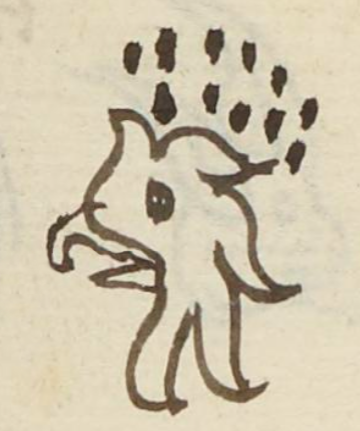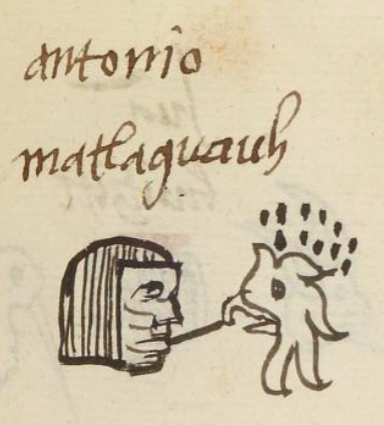Matlaccuauh (MH506r)
This black-line drawing of the combined simplex glyph for eagle (cuauhtli) and notation for the number ten (matlactli) is not only a personal name but also a date. The eagle was a day sign in the calendar of 260 days called the tonalpohualli, and calendrics were an important part of Nahuas' religious views of the cosmos. The eagle consists of a head only, in profile, looking toward the viewer's left. The feathers on its head and neck are spiky or wispy. Its visible eye seems to be open, as is its beak. Above the head of the eagle are a cluster of black dots (actually eleven dots, rather than the expected ten, if we trust the gloss).
Stephanie Wood
The cuauhtli day sign could have a companion number between 1 and 13, depending upon which day in the 260-day cycle one was considering. The divinatory calendar (tonalpohualli) could be consulted to learn the potential fate of a baby born on that day.
Stephanie Wood
antonio
matlaguauh
Antonio Matlaccuauh
Stephanie Wood
1560
Jeff Haskett-Wood
números, águilas, fechas, calendarios, días, tonalpohualli, feathers, plumas, mahtlactli, nombres de hombres

matlac(tli), ten, https://nahuatl.wired-humanities.org/content/matlactli
cuauh(tli), eagle, https://nahuatl.wired-humanities.org/content/cuauhtli
Diez Águila, 1-Águila
Stephanie Wood
Matrícula de Huexotzinco, folio 506r, World Digital Library, https://www.loc.gov/resource/gdcwdl.wdl_15282/?sp=91&st=image
This manuscript is hosted by the Library of Congress and the World Digital Library; used here with the Creative Commons, “Attribution-NonCommercial-ShareAlike 3.0 License” (CC-BY-NC-SAq 3.0).



